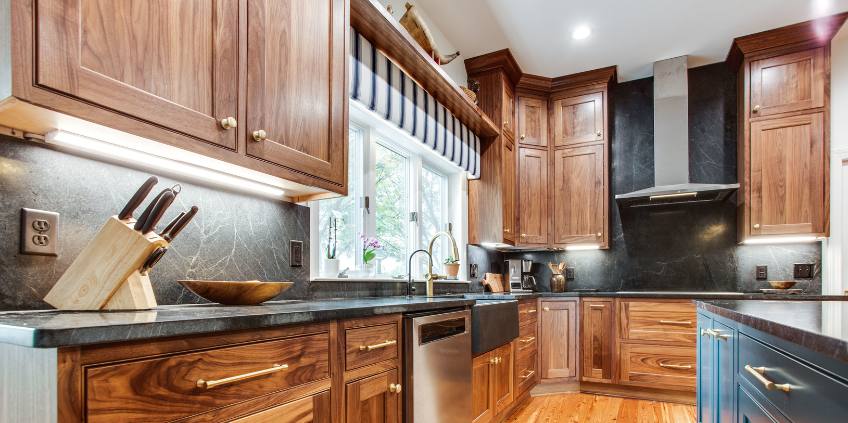We know that your house is one of your largest investments. One of the main areas most exposed to bacteria, dirt and grease in your home is your kitchen cabinets. Grease from cooking, condensation from external temperatures and children opening and closing your kitchen cabinets constantly throughout the day calls for routine upkeep. As if that was not enough, we also know that your kitchen and subsequently your kitchen cabinets, are often a focal point in your home.

What to use to clean your kitchen cabinets
We want to help you master the maintenance and let your cabinets shine like they were meant to with some simple rules to follow for cleaning your kitchen cabinets. All manufacturers should have a manual that provides guidance on what to use and what not to use when cleaning. Generally speaking, you should clean your kitchen cabinets with water or simple dish soap with a soft clean cloth. You definitely want to stick to more common cleaning agents such as baking soda and vinegar. For certain, it should always be something non-abrasive so as to not mar the surface of your cabinets. Here are some guidelines:
- Detergent: You can use any oil/grease cutting laundry or dish detergent and water to clean your wood cabinets. Opt for two cups of water with every cup of detergent ratio. Make sure to not over wet the cabinets because it could damage the finish. After applying the solution, wipe it down with a damp cloth first, followed by another dry cloth.
- Vinegar: Vinegar mixed with water is another alternative. Vinegar works well for removing sticky films typically caused by fingerprints, dirty hands and/or grease stains from cooking.
- Baking Soda: The difficult stains should be treated with baking soda. Mix the baking soda with water to make your own paste, let it sit briefly, and then wipe it with a wet cloth. Food splatter stains can often be remedied with this option.
This will typically cover the majority of your needs…the food splatters, fingerprints, water marks and more. Have a few black scuffmarks? No cleaning agent needed here. A soft eraser, gently rubbed along the mark, can most often do the trick.
What you should not use to clean your kitchen cabinets
Conversely, here are the products you definitely want to stay away from when cleaning your kitchen cabinets:
- Glass Cleaners like Windex, which contain Isopropanol, alkylbenzene Sulfonic Acid, Methyl Ester and Propylene Glycol
- Comet, which contains Sodium Carbonate and Calcium Carbonate
- Spic and Span, which contains Sodium Silicate and Sodium Carbonate
- Ammonia
- Tilex, which contains Sodium Hypochlorite
- Pledge/ Furniture polish, which contains silicone emulsion waxes
- Hand Washing liquid, which contains Sodium Laureth Sulphate and AlphoSulfo Methyl Ester
What type of kitchen cabinets you have dictates how you clean them

Cleaning cabinets mainly depends on the kind of cabinets you own (Learn more about Cabinet Basics here). Here are some standard cabinet cleaning recommendations based on the type of kitchen cabinets you have:
- Wood Cabinets: An oil-soap wood cleaner is your best bet for wood cabinets. However, you could also clean wooden cabinets with materials you may already have. Use a damp cloth and the buff after with a microfiber or similar cloth.
- Laminate Cabinets: The substance of laminate lends itself to typically easier cleaning of your kitchen cabinets. Diluted vinegar or non-abrasive cleaners offer a quick wipe down. Similar to wood kitchen cabinets, be sure to always wipe down with a soft, clean cloth after using your cleaning agent.
- Painted Cabinets: Very popular in the kitchen, especially considering white is a near timeless kitchen cabinets choice, painted kitchen cabinets require just as much attention as their wood and laminate counterparts. A gentle 2-part wipe down with a damp cloth followed by a dry cloth should take care of general cleaning. When it comes to cleaning stubborn stains on painted cabinets, the same rules apply as with wooden cabinets, meaning baking soda mixed with water is your best option. If you are working with a water-based latex style of paint, be careful when scrubbing your cabinets. Baking soda can potentially scratch that surface, so opt for nonabrasive all-purpose cleaner and warm water, gently rubbing the surface. Be sure to test your selected supplies on small, concealed areas to ensure you are not damaging the finish or color.
How often should you clean your kitchen cabinets
Your cabinets do not need to be wiped down daily or 3-4 times a week. It is not necessary and frankly, we do not think you have the time! Instead, look at your kitchen cabinets weekly and identify targeted areas to wipe down damp and then dry. Your cabinet hardware should always be a focus point to clean and disinfect every time you are spot-checking.
For a more thorough cleaning, considering emptying your kitchen cabinets every 6 months and wiping them down from the inside out. Remember to always use the 2-part wipe down approach, damp then dry. Depending on your cabinet type, this would be the ideal time to use that oil soap wood cleaner or do that full wiped down versus your weekly spot check and clean.
Beware of the effects of heat and moisture on kitchen cabinets
A word of caution as well when it comes to the effect of heat and moisture on your kitchen cabinets. Do not expose finished cabinets to high heat or high moisture. When using the self-clean cycle of your oven, broiling with the oven door open or allowing steam to constantly float up and over your cabinets, open the doors and drawers of adjacent kitchen cabinets to lessen exposure to high heat. Be cautious as well of countertop appliances such as tea kettles, vegetable steamers, toasters, etc. that create high moisture or high heat. Place coffee makers in front of upper cabinets so the steam will rise in front of the cabinet door as opposed to under the light valance. Be careful with candles or strong light fixtures placed near finished surfaces because they can cause discoloration.
We hope these tips help you keep your cabinets looking their best. For more expert recommendations on cleaning your cabinets or starting your new dream kitchen, request a consultation now with a Reico Kitchen & Bath professional.

